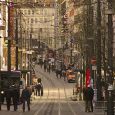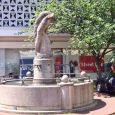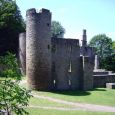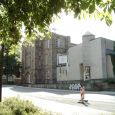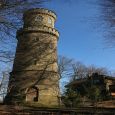Witten
Advertisement
By Train
The Witten central station is located on the double-track electrified line 427 DB timetable of Hagen Hbf to Dortmund Central Station or Hauptbahnhof Bochum.These lines were 1848 or 1862 of the Bergisch-Markische Railway Company built another railway-Witten Wengern East / Schwelm on the other side of dysentery was in the 30s of the German Railway opened.Today they are used for passenger transport, the distance rail passenger traffic and freight use.
By Bus
In the road passenger transport there is a wide range of tram - and buses.They are operated with a few exceptions to the BOGESTRA.For the entire public transport is the rate of traffic by the Rhine-Ruhr and collective space border of NRW-Tarif.In the transition rate also applies to the tariff of the Community Transport Ruhr-Lippe.
By Ferry
On the upside dysentery in the summer of the excursion boat Schwalbe II Stadtwerke Witten 3 to 4 times daily.Investors: Bommern Embankment, Nightingale Colliery, Hard stone ruins, Herbede lock, bridge and Leisure Lake Herbede Heveney.At leisure Heveney is a trip interchanges to ship MS Kemnade.The boat runs 4-8 times a day Kemnader on the existing reservoir since 1979. Piers are: Seglerhaus port Heveney, Kemnade Weir Oveney, herded south shore, leisure Heveney.
By Road
Witten is the federal highways 43, 44 and 45 connected to the trunk road network, being located at the junctions of the A43 and Witten Witten-Heven Herbede.On the A44 and the connecting points of Witten-Zentrum, Witten-Stockum and Witten-Annen.And at the junction of the A45 Witten-Stockum.
Witten Days for New Chamber Music
is a music festival for contemporary chamber music, jointly organised by the town Witten in the Ruhr Area and the broadcasting station Westdeutscher Rundfunk (WDR).The concerts take place over a weekend at the end of April or in early May, and concentrate on world premieres of small-scale works, more than 600 as of 2010.They are broadcast worldwide via the European Broadcasting Union.The composer Robert Ruthenfranz founded the Wittener Musiktage in 1936.After World War II the festival was held at irregular intervals (1947, 1948, 1950, 1953 and 1957), until 1960 when it became an annual event.In 1969 the WDR took over the running of the festival, and it received its present name.From 1969 to 1989 Wilfried Brennecke of the WDR was responsible for the programming, focussing on composers portrait concert since 1978 and introducing composers from countries behind the Iron Curtain, such as Gyorgy Kurtag.The festival of 2010 was an event of the European Capital of Culture in the Ruhrgebiet, called RUHR2010. Featured composers were Matthias Pintscher and Jörg Widmann, both students of Hans Werner Henze.[2] Other composers included Beat Furrer who founded the ensemble Klangforum Wien 25 years before, Enno Poppe (1969), Salvatore Sciarrino, Bernhard Lang and Friedrich Cerha.
Markisches Museum
Which presents mostly modern German painting.It is up to the Husemannstrabe 12 in Witten.The core of the collection is about "4,000 paintings, sculptures and graphic works" of modern painting in the 20th Century in Germany.The museum features works by several major Expressionists, including paintings by Max Pechstein, Ernst Ludwig Kirchner, Emil Nolde, Erich Heckel, Conrad Schafer, August Macke, Gabriele Munter and Henry Campendonk Of special interest is the Westphalian Expressionists Wilhelm Morgner and Christian Rohlfs.Other collection priorities are the Neue Sachlichkeit (including works by Eberhard Viegener, Josef Wedewer and Elizabeth Schmitz ) and the critical realism (including works by Rissa, Wolfgang Petrick, Hans-Jürgen Diehl, Maina-Miriam Munsky, Lambert Maria Wintersberger, Konrad Klapheck, Bruno Goller ).By his own account the museum also houses the largest collection of German Informal.Origin of the museum was formed in 1886 Association for Local and National History in the county of Mark , the notables of the city founded Witten. First collected relatively unprincipled curiosities, but also newspapers and gray literature archived in the region, the foundation of today's extensive Westfalica formed collection. 1909 - 1912 the museum building was erected.
Hoist Museum
shows old machines for lifting and moving loads.It is owned by JD Neuhaus, since 1745 the lifting equipment manufactures.In 1977, Johann Diederich Neuhaus began from the sixth generation of the family business of construction hoist Museum.Both in their own possession historic hoists are issued and corresponding pieces of competing companies and other industries, supplemented by models and information panels.The wind wrought figurines of 1745 has been in style and function of the time around 1900, restored and furnished.In the 1985 mock "wind factory JD Neuhaus" is an old drive transmission, the twelve machines (including milling, planing, lathe, band saw drives).In the outdoor complex is the functional replica of the old crane of the Hanseatic city of Lüneburg from 1336, which was used for loading and unloading of ships.The museum in the district Heven has only temporarily - opening - usually on Sundays.When interest group tours (for example, for school classes) are possible.It is the only museum of its kind in Germany.
Mines and mine Feldbahnmuseum Theresa
is a technical museum in Witten-Bommern.It is located at the entrance to Muttental and is part of the most significant historic mining trail in Germany, the mining trail Muttental.The museum was opened after 13 years of construction time in 2002.It is operated by the established in 1986 and is a recognized "Muttenthalbahn Association eV".The purpose of this association is historically significant railway vehicles from the mining and railway field area within a museum collection, and possibly operable to preserve for posterity.The museum runs an extra term for the visitors railway line from the parking lot by the nightingale road mines and Feldbahnmuseum up on the grounds of the fiber optic industry museum Nightingale Colliery leads. On the site of the colliery closed in 1892, Theresa will be issued as early as 1989 locomotives and wagons.The vehicle collection consists of 92 locomotives and 200 wagons (April 2006). It will be exhibited diesel, electric and compressed air locomotives, cars and trams from mining as well as many from the field Loren railway sector.
LWL Industrial Museum
is a decentralized museum with eight locations in Westphalia and Lippe.The headquarters is located in the colliery in Dortmund.The museum sites Zollern, Hanover and the nightingale, the ship lift, the Henrichshutte and the Brickyard are anchor points of the European Route of Industrial Heritage (ERIH) and the route of industrial culture in the Ruhr area.Body of the museum is the Regional Association of Westphalia-Lippe.
Information not available


